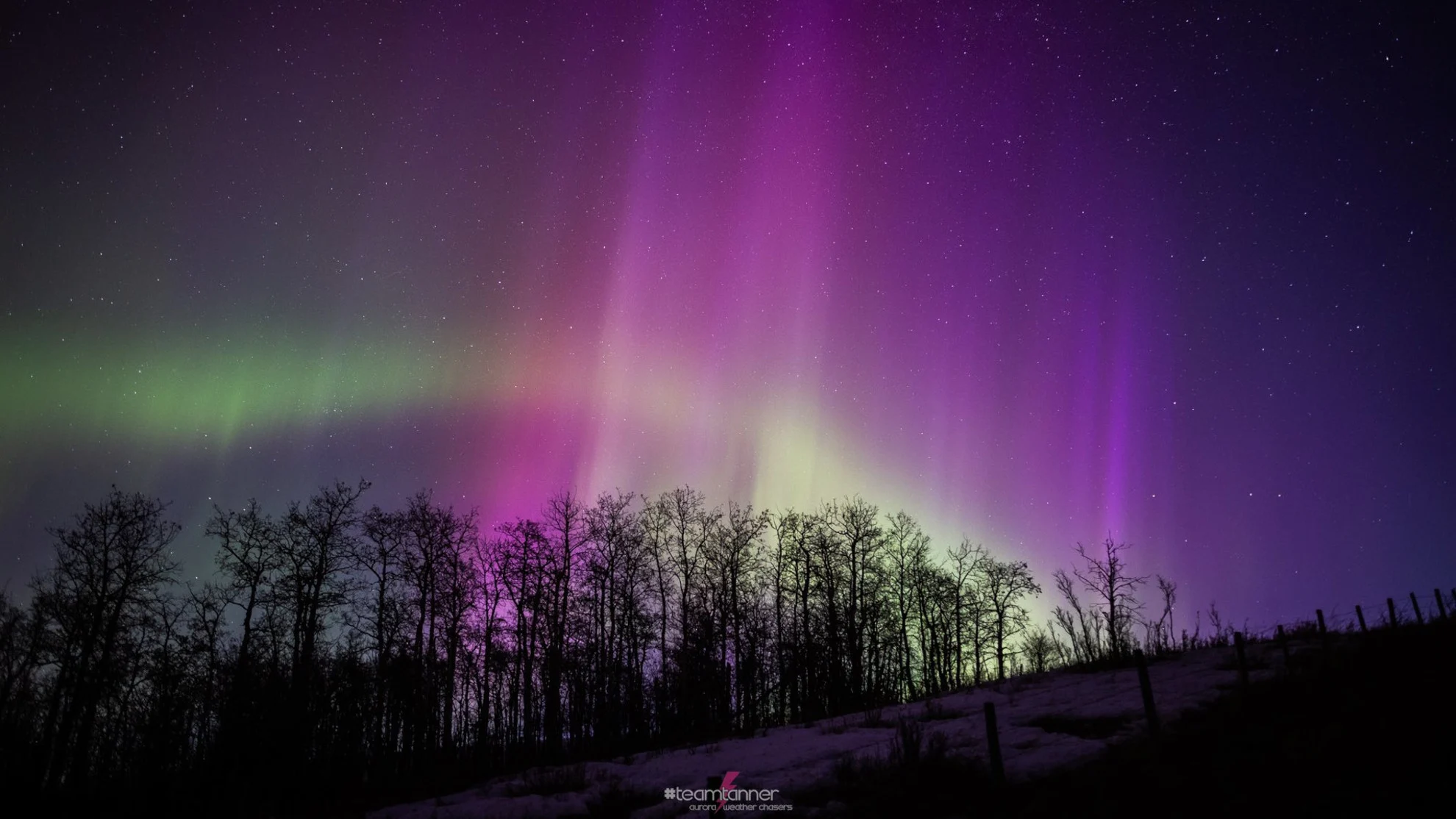
How do the Northern Lights shine? Here's the science behind auroras
The auroras are one of the most direct ways that we experience the awesome and variable activity of our home star, the Sun.
We are witnessing more frequent and vibrant displays of the Northern Lights in our skies lately. Why is this happening, how do these beautiful coloured lights appear, and what can we look forward to? Here's the science behind the auroras.
From here on Earth, the Sun may appear to be a constant as it travels across our sky each day. However, if we look closer at this giant, fusion-powered ball of superheated gas, we'll find that many aspects of it are far from constant.
In fact, our Sun is actually known as a variable star.
Solar cycles
Every 11 years or so, the Sun goes through a pattern of increasing and then decreasing activity.
This is what scientists call the solar cycle.
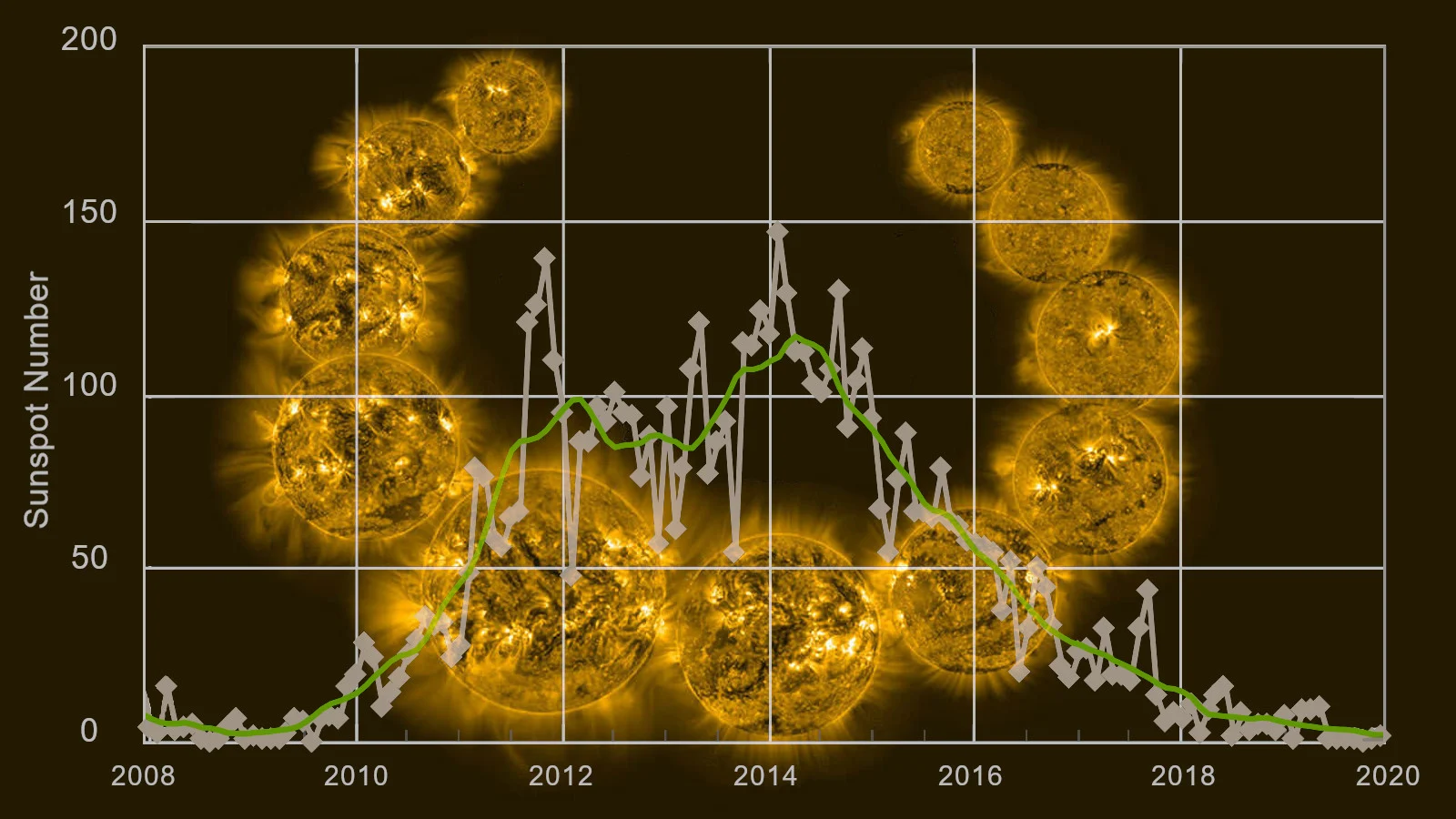
The progression of Solar Cycle 24, which took place between 2008 and 2019, is shown here, both in the number of sunspots seen on the Sun's surface each month (foreground graph) and the Sun's magnetic activity during of each year of the cycle (background images). (NASA)
Over the past 270 years, we've tracked a total of 24 complete cycles. The latest one, Solar Cycle 25, began in December 2019. As of August 2024, we are nearing its peak, when we will see maximum activity.
While each solar cycle unfolds in its own unique way, they all follow a similar pattern.
The Sun starts off each cycle with a nearly unblemished visible 'surface'. Over the next five or six years, the number and intensity of sunspots, solar flares, and solar eruptions gradually increases until it reaches a peak. After that, activity ramps down again to a minimum, and then the next cycle begins.
Solar activity
During the course of its solar cycles, the Sun produces an array of different phenomena that we generally refer to as 'solar activity'. Much of this also falls under the category of 'space weather'.
Firstly, regardless of what else is going on with the Sun or where it's at in a solar cycle, it emits a steady flow of charged particles, known as the solar wind.

A comparison of three different views of the Sun, showing sunspots, magnetic field activity, and activity in the Sun's atmosphere (the corona), are shown here from both December 9, 2019 (top row) and August 9, 2024 (bottom row). (NASA SDO/Scott Sutherland)
READ MORE: Once-in-a-lifetime northern lights dance across North American skies
As a solar cycle progresses, magnetic activity on the Sun's surface increases. Cool, dark regions of the Sun, called sunspots begin to appear, and large coronal holes open up in the Sun's atmosphere, allowing faster streams of the solar wind to flow out into space.
Sunspots tend to be surrounded by massive arcs of solar matter, composed of millions to billions of tons of superheated plasma, known as coronal loops. These can extend thousands of kilometres from the surface and are held aloft on the magnetic fields.
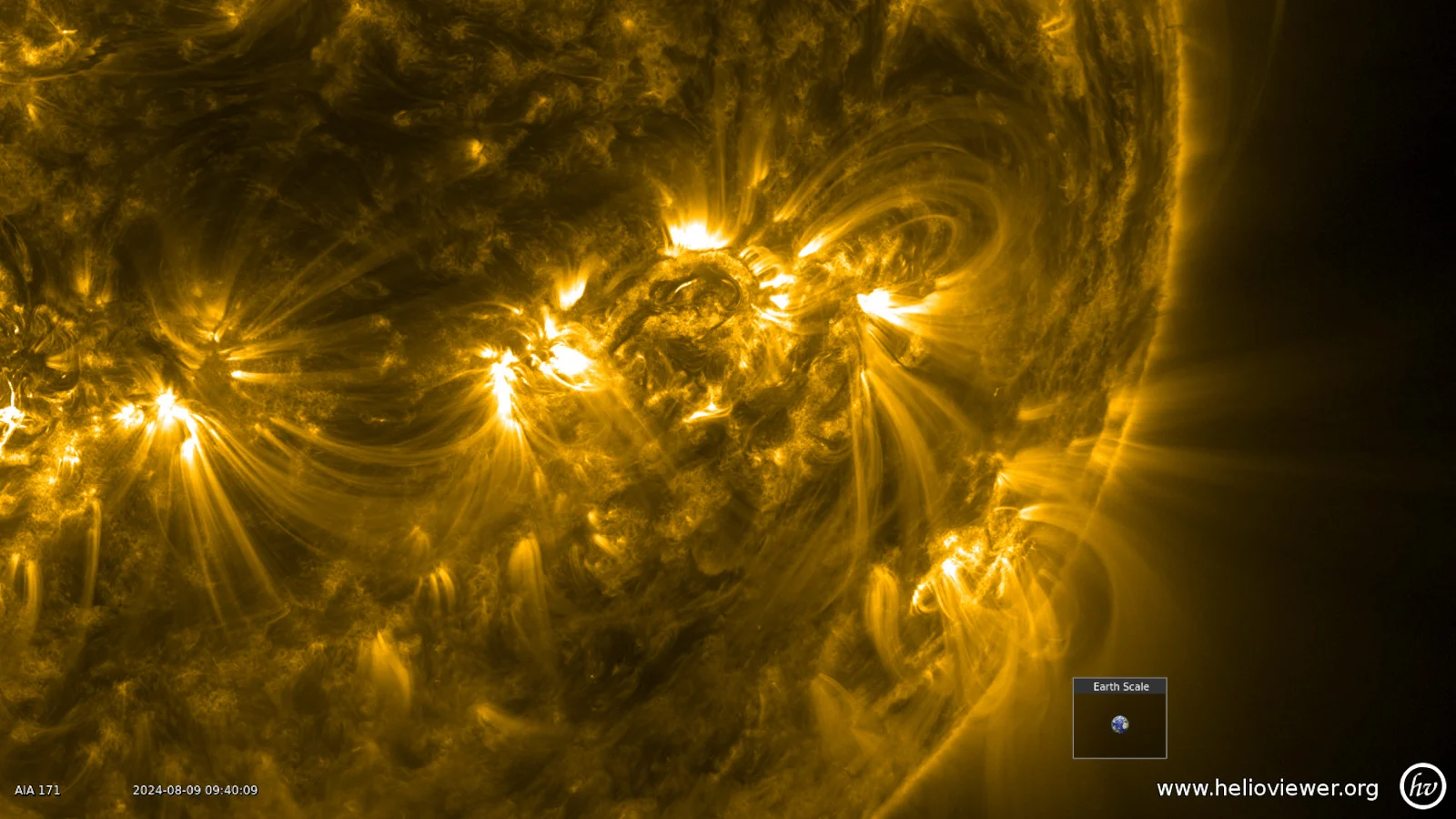
Several active sunspot regions are featured in this image of the Sun's magnetic activity from August 8, 2024. Immense structures known as 'coronal loops' arch out from the Sun's surface, connecting to the Sun at the bright spots. Each of these loops has millions to billions of tons of charged solar plasma wrapped around it. Earth is shown to the bottom right for scale. (NASA SDO/Helioviewer.org)
An individual sunspot typically only lasts a week or two before fading. However, as we approach the peak of a solar cycle, the number of sunspots increases, and we tend to see larger and more complex sunspots, which can even form into immense interconnected groups.
The larger and more complex a sunspot is, the more likely it is to produced a solar flare — an intense burst of energy released when the chaotic tangle of magnetic fields surrounding a sunspot suddenly unravels. Flares happen over a range of intensities, from the tiny almost imperceptible A- and B-class, to the minor C-class, the moderate M-class, and the extreme X-class.

The solar flare scale is shown here, with each class being a 10-fold increase in power over the class below (X-class is 10 times more powerful than M-class, but 100 times more powerful than C-class). While A, B, C, and M-class flares are ranked by a number 1-9 (ex: C5-class, M9-class), X-class flares can be ranked far higher (the most powerful so far being an estimated X45, on September 1, 1859). (NASA/Goddard Space Flight Center/Scott Sutherland)
Although there have been some exceptions, generally, the strongest solar flares occur closer to the peak of a cycle.
Similarly, the closer we are to the peak, the more eruptions from the Sun's surface we tend to see. These coronal mass ejections are the result of coronal loops snapping during a solar flare, or when an immense solar prominence destabilizes and peels away from the Sun's surface.
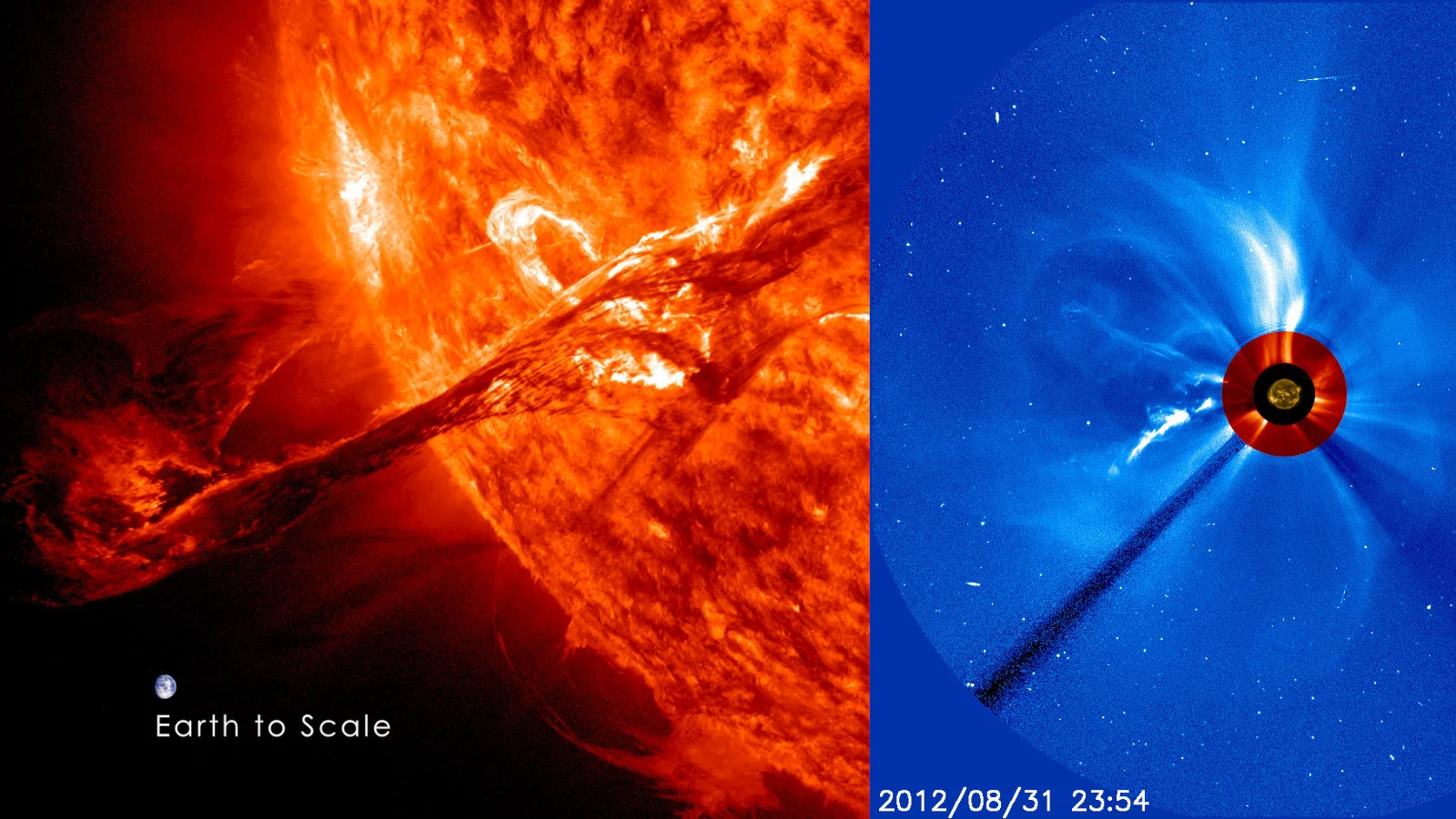
This immense arc of solar matter stretched and snapped away from the Sun's surface on August 31, 2012, captured beforehand by NASA's Solar Dynamics Observatory (left), and several hours after it erupted into a CME, caught by the coronagraph instrument on the NASA/ESA Solar and Heliospheric Observatory (right). (NASA SDO)
DON'T MISS: Blackout-causing 'super' solar storms happen more often than we thought
As a CME expands away from the Sun, it typically takes around three days to reach Earth's orbit. However, if they receive an especially hard kick into space via a powerful X-class solar flare, they can arrive much sooner, in as little as 15 hours!
If Earth happens to be in a solar storm's path, the cloud of charged particles flowing past us will cause a disturbance in Earth's magnetic field, known as a geomagnetic storm.

In this simulation, a CME interacts with Earth's geomagnetic field (left), then particles from the CME are captured and channeled towards the poles, where they produce displays of the Aurora Borealis and Aurora Australis. (NASA/Scott Sutherland)
As the solar storm passes by, the geomagnetic field of Earth captures particles from the cloud and funnels them down into the atmosphere near the poles. The denser a CME is, the more energy contained within it, and the faster it sweeps past us, the stronger the resulting geomagnetic storm will be. And the stronger the geomagnetic storm, the brighter and more expansive the auroras will will be.
A minor geomagnetic storm (G1) will push the auroras down over Labrador, northern Quebec and Ontario, and the central Prairies. Auroras from an extreme storm (G5) will be visible from the southern United States, and possibly even farther!
The Auroras

The Aurora Borealis, captured on November 4 from central Alberta. (Team Tanner)
The Northern Lights and Southern Lights, also known as the Aurora Borealis and Aurora Australis, are the result of high energy particles from the Sun diving into Earth's atmosphere, where they encounter oxygen atoms and nitrogen molecules.
Interacting with these atoms and molecules, the particles pass on some of their energy in the process. In turn, the oxygen and nitrogen release that energy as flashes of light. With billions of particles flowing in from space at any one moment, this results in an arc of coloured light extending for thousands of kilometres, hovering between 80 and 250 kilometres above the ground.
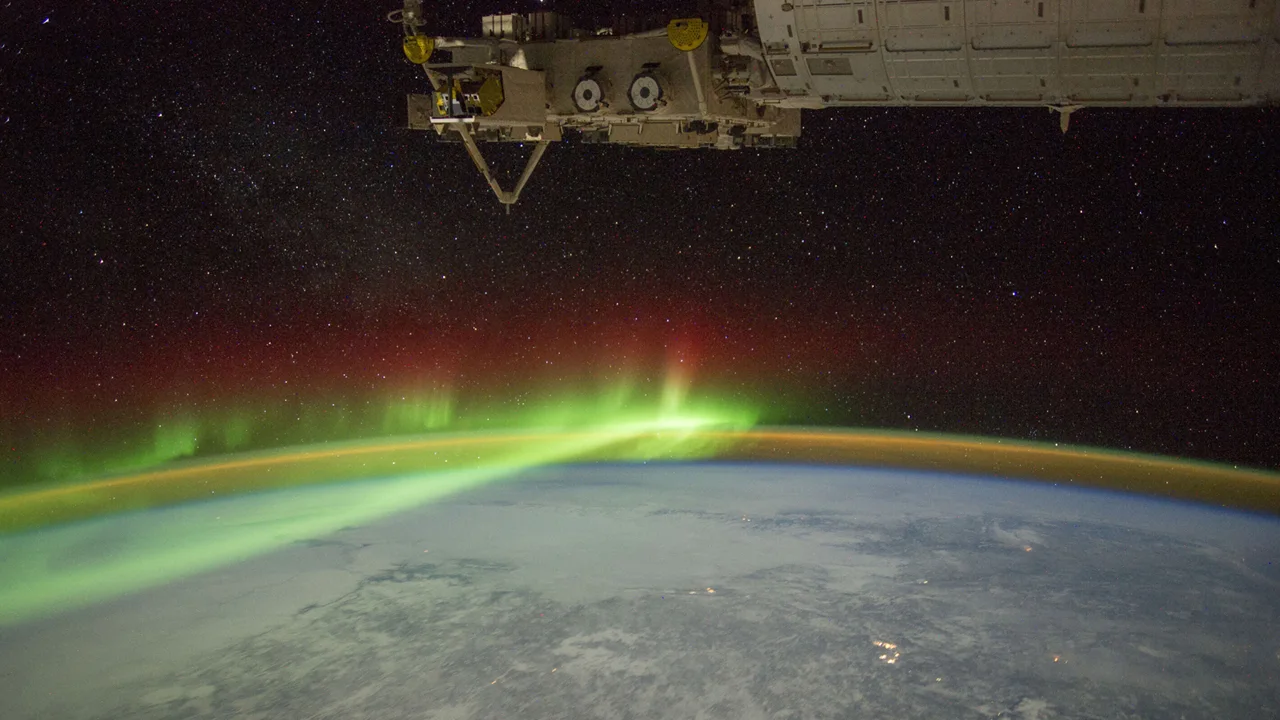
This view from the ISS from 2015 shows green and red auroras high up in the sky. Credit: NASA/JSC/ESRS
The colour of the aurora depends on exactly which atoms or molecules are being energized by the solar particles.
The most common colours, green and red, are produced by oxygen atoms. Green shows up around 100 km above the ground, where the air is thin enough that these atoms are less likely to bump into one another. Red auroras tend to happen right along with the green ones, but are less commonly seen by us. They occur even higher up, where the air is even thinner. So, there needs to be far more solar particles energizing the atoms at those altitudes for the red light to become more noticeable.
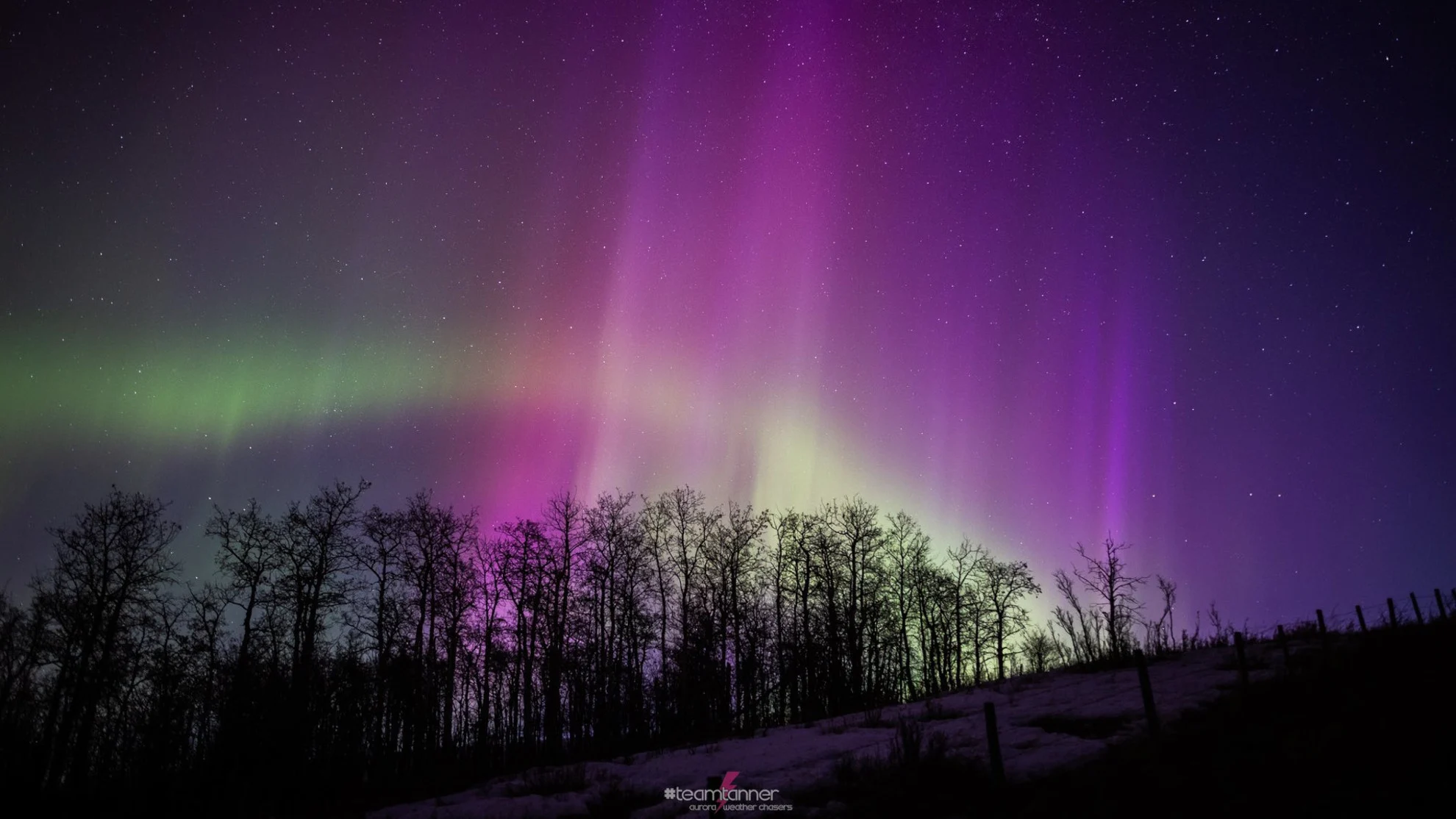
This amazing, colourful display of the Northern Lights was captured by Tree and Dar Tanner from central Alberta on March 23, 2023. (Team Tanner)
More rarely, colours like blue and purple can show up. These are typically the result of high energy solar particles reaching deep enough into the atmosphere where they can interact with nitrogen molecules. The molecules then release light in shades of blue and red. The blue can show up on its own, or mix with the red to produce purple. This only occurs during the strongest geomagnetic activity.
Even rarer still are colours like pink and yellow, which are the result of other colours of light — red, along with green or blue — overlapping in the sky. While the atoms and molecules are releasing the same colours of light they normally do in these situations, the combined wavelengths of light mix together and appear as these other hues.
How to see (and capture) the auroras
Seeing the auroras for yourself is a magical experience. It is far from easy, though.
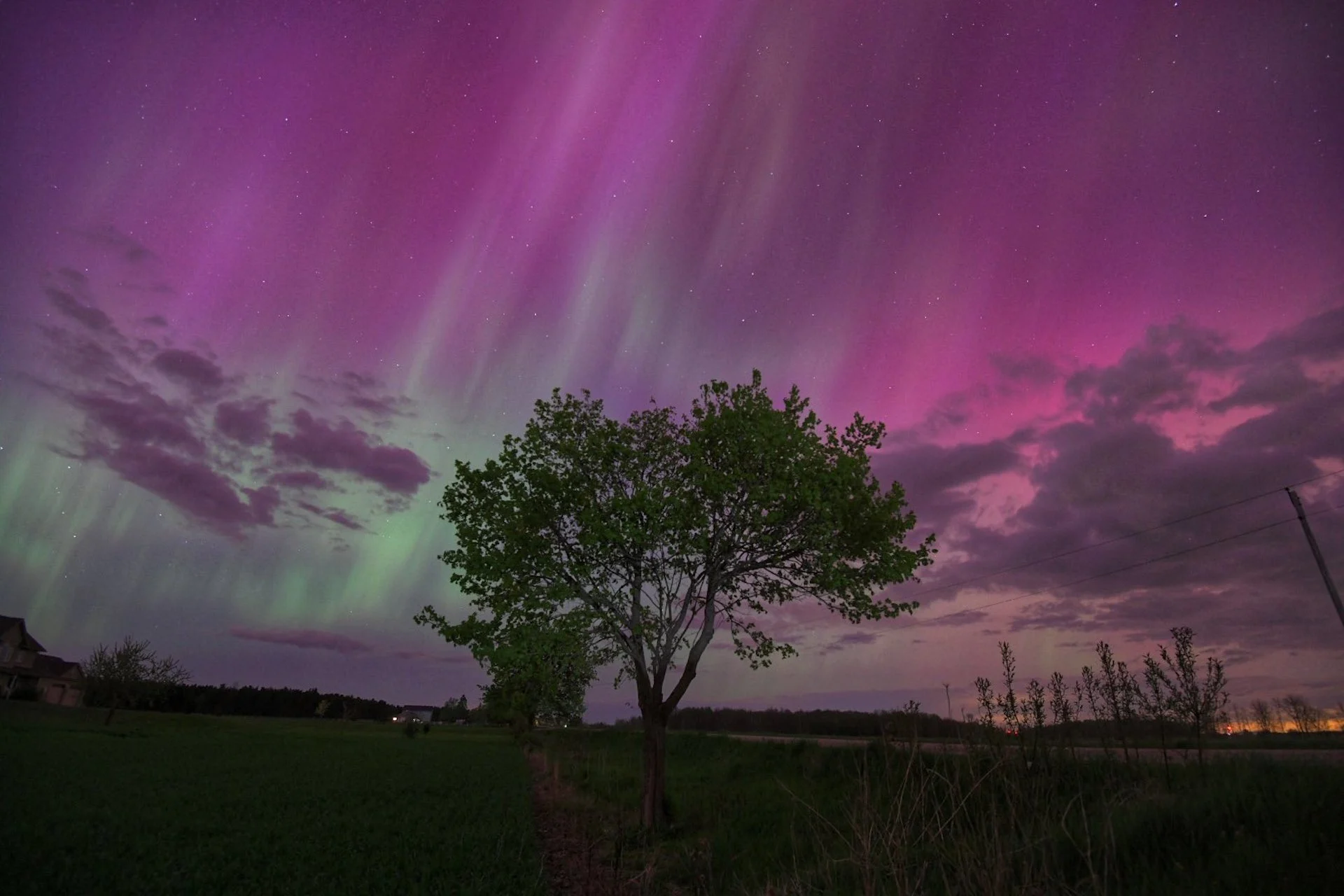
The Northern Lights, captured by Stormhunter Mark Robinson on the night of May 10, 2024. (TWN/Mark Robinson)
Auroras can be active for hours at a time. However, these displays can shift and change quite a bit, appearing as a distant ribbon of light along the northern horizon one minute, then suddenly splashing colour across the sky overhead the next, and retreating again just as quickly.
Complicating matters even further, many of us live in urban centres where our view of the night sky is largely spoiled by city. For those trapped under urban light pollution, the key is limiting how much artificial light comes between you and the sky.

This graphic shows the different levels of light pollution typically experienced in regions from dense urban environments to the most remote Dark Sky Preserves. (NOIRLab)
Even if the auroras are right overhead, they are not always bright enough to be easily seen without some kind of assistance. Due to the nature of human night vision, we tend to see shapes better than colours (remember that many aurora photographs shared on the internet are long-exposure images).
This is where a camera comes in handy — even a cellphone camera. Switch to using the Night mode, Night Sight setting, or the equivalent, so that your phone will take a long-exposure image. The colours will show up much brighter in the pictures than they will to your unaided eye.
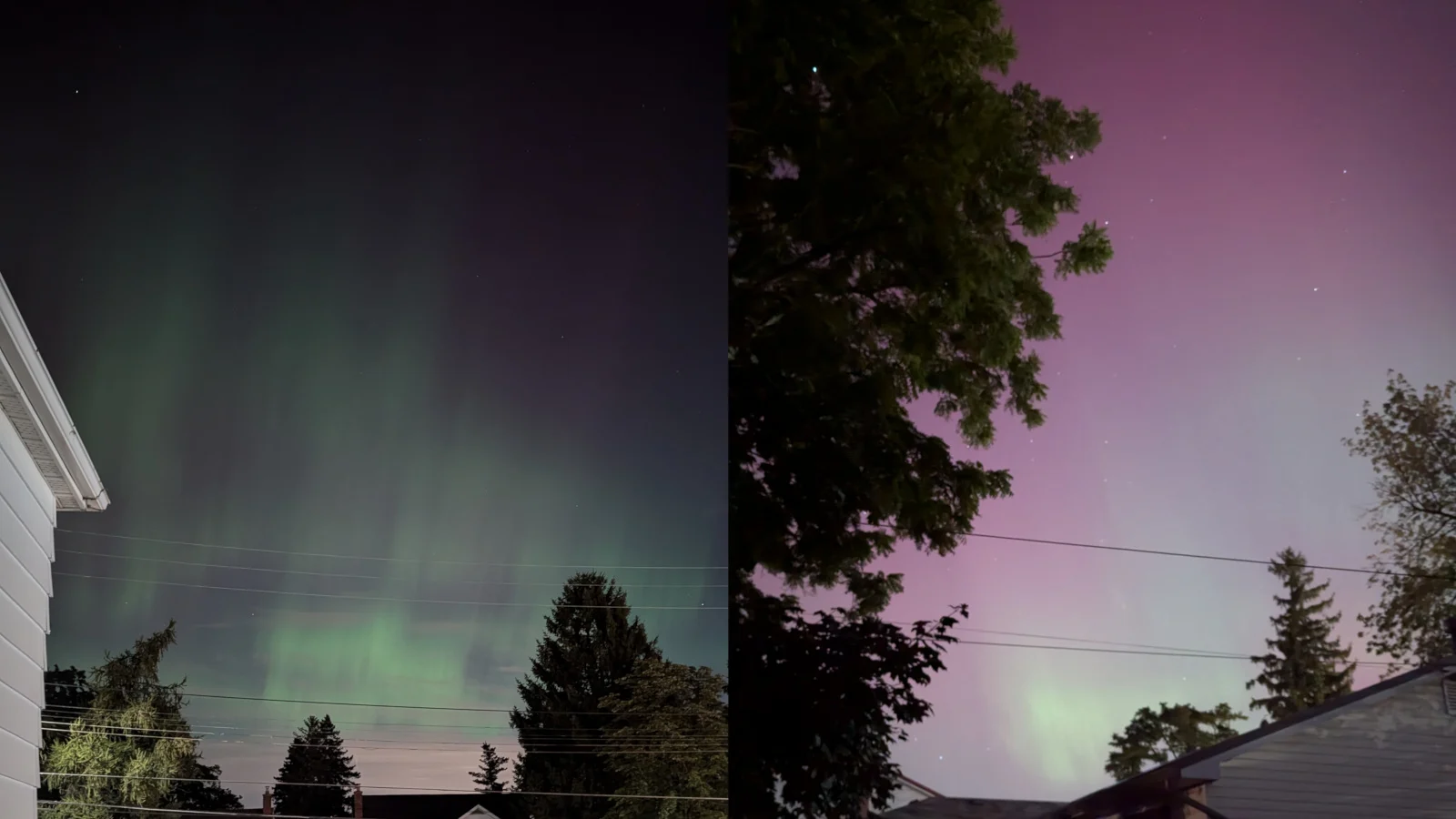
Two views of the auroras from August 12, 2024, taken roughly 20 minutes apart, from Hamilton, Ontario. While the patterns — the ribbons and pillars of light — were easily visible to the unaided eye, the colours only revealed themselves in these photographs. (Scott Sutherland)
We have already seen some amazing displays of the Northern Lights across Canada over the past year or so. As solar activity continues to increase as we approach solar maximum (expected sometime in 2025 or 2026), we're sure to have many more opportunities to see the auroras shining in the sky above.
Keep an eye on Weather Network News for updates on space weather forecasts as this solar cycle progresses.










